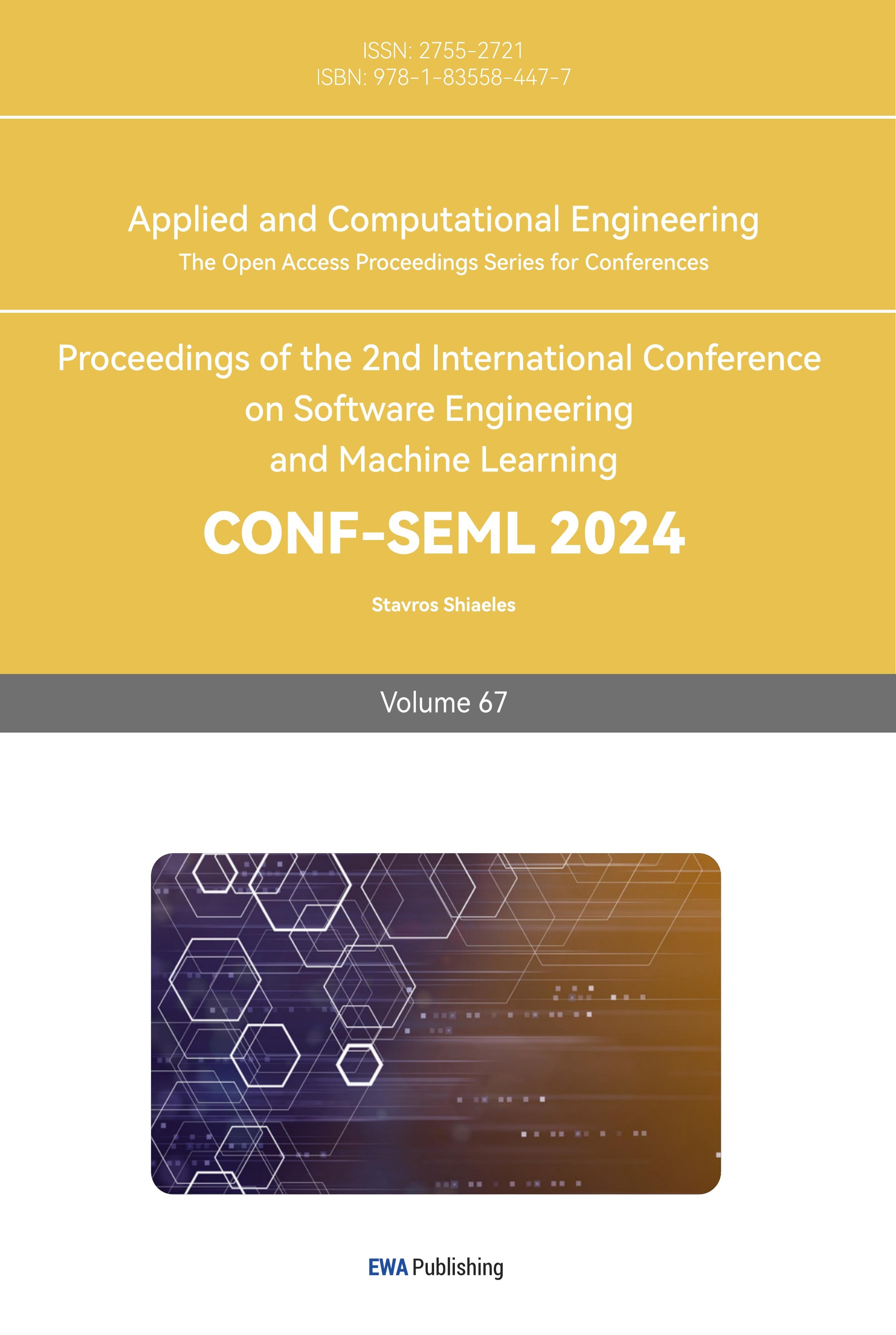1. Introduction
Computer Graphics (CG) is a vibrant and colorful branch of computer science that plays a central role in the fields of modern visual arts and technology [1]. With the advancement of technology, the application areas of CG have far surpassed its initial realms of animated movies and video games, expanding into virtual reality (VR) [2], 3D printing [3], personalized creation, scientific visualization, and more. These applications not only enrich our daily lives but also continuously push the boundaries of technology and art [4].
In the vast domain of CG exploration, constructing models with cultural symbolism is particularly appealing. The Chinese dragon, an important symbol in Chinese culture, has always been a focal point in the realms of art and design [5]. It not only carries rich cultural connotations but also becomes an ideal subject for 3D modeling practice due to its unique form and dynamic features. By modeling the Chinese dragon, designers and artists can not only showcase their understanding and respect for traditional culture but also challenge and enhance their technical skills in 3D modeling.
In the field of modeling, there are many 3D modeling tools with unique functions and characteristics, catering to different modeling needs. Blender [6] is a comprehensive open-source 3D creation suite that supports the entire 3D pipeline, from modeling, animation, and simulation, to rendering, compositing, and video editing. It is suitable for artists and designers engaged in creative design and animation production. Autodesk Maya [7] is a powerful professional software package for 3D animation, modeling, simulation, and rendering, widely used in film, television, and game development. Maya is renowned for its advanced animation tools and powerful modeling capabilities, making it suitable for professionals working on complex projects. Tinkercad [8] is a simple, online 3D design and 3D printing tool ideal for beginners and educators. It allows users to quickly get started and is used to realize simple design ideas. Rhino [9] is famous for its powerful NURBS (Non-Uniform Rational B-Splines) modeling capability, enabling users to create, edit, analyze, and translate complex mathematical surfaces. It is very suitable for professional fields that require detailed modeling and high-quality surface modeling.
This paper aims to explore how OpenSCAD's parametric and scripting capabilities can be employed to construct a complex dragon model, addressing the main technical challenges and solutions encountered in the building process. The goal is to enhance our understanding of CG technology in the application of complex biological modeling and to spark enthusiasm for innovative design. Through this research, we hope to provide practical guidance and a theoretical basis for OpenSCAD's application in the domain of complex 3D modeling, demonstrating its potential when paired with effective design strategies and supplementary tools.
2. Related work
OpenSCAD is a powerful script-based 3D CAD modeling tool that allows users to create complex three-dimensional models through code, providing precise and repeatable design methods [10,11]. This approach is particularly suitable for scientific and engineering designs requiring high precision and repeatability. The utilization of OpenSCAD for educational and restoration purposes is exemplified by two contrasting case studies, highlighting the software's advantages and limitations in handling complex models. In the article "3D Printing of Police Whistles for STEM Education" by Masato Makino et al. [12], OpenSCAD was employed for precise modeling of police whistles. Although these models exhibited high accuracy in dimensional proportions, they seemed to lack detailed construction in appearance, thereby imposing certain limitations on their visual appeal. This underscores a common challenge with OpenSCAD: while excelling in geometric precision, it may not fully showcase fine aesthetic details without extensive customization.
Conversely, in Linghan Zheng's article "Restore Traditional Chinese Lanterns Based on OpenSCAD and Three.js" [13], OpenSCAD was utilized for the restoration of traditional Chinese lanterns, demonstrating a high level of model fidelity. However, the details of the lanterns, particularly in decorative elements, did not fully exploit OpenSCAD's potential in constructing complex models. This suggests the need for integrating additional tools or techniques to enhance the fine detailing in models.
In further exploration of OpenSCAD, a new case study focusing on the theme of Chinese dragons, a symbol deeply rooted in traditional Chinese culture, was conducted. By integrating the Chinese dragon symbol with modern 3D modeling technology, the potential of OpenSCAD in constructing complex biological models was investigated. In the study titled "OpenSCAD Application in 3D Modeling of Chinese Dragons," researchers attempted three-dimensional modeling of Chinese dragons using OpenSCAD software. Through parameterized design of dragon features such as body structure, scale texture, and head details, researchers successfully created highly realistic 3D dragon models. These models not only demonstrated high geometric accuracy but also exhibited excellent performance in terms of details, such as the layered scales and facial expressions of the dragons. This study showcased OpenSCAD's potential in handling complex biological models, particularly in the representation of traditional cultural symbols.
Moreover, in another study titled "Cultural Inheritance and Education through 3D Printing of Chinese Dragons Based on OpenSCAD," researchers explored the cultural significance and educational value of using OpenSCAD for 3D modeling of Chinese dragons. By modeling various parts of the dragon in OpenSCAD and incorporating traditional cultural elements such as dragon patterns and auspicious symbols, researchers produced a series of 3D dragon models with distinct Chinese cultural characteristics. These models not only demonstrated the technical application of OpenSCAD but also opened up new possibilities for the digital inheritance of traditional culture. Additionally, these dragon models could serve as educational tools to introduce students to the symbolic meanings and artistic representations of dragons in traditional Chinese culture.
These case studies not only showcase OpenSCAD's potential in constructing complex biological models but also highlight its significant role in cultural inheritance and education. By combining modern 3D modeling technology with traditional cultural themes, OpenSCAD provides an innovative tool for artists, designers, and educators, facilitating the digitization of traditional culture and opening up new possibilities for cultural education and inheritance. Therefore, using OpenSCAD for dragon modeling not only explores the software's parametric design capabilities but also provides new insights and methods for three-dimensional modeling of complex organisms. In this paper, researchers sought to highlight the distinctive features of these cultural symbols within the context of OpenSCAD modeling. Unlike typical biological models, Chinese dragons possess unique characteristics deeply rooted in traditional Chinese culture. These include the dragon’s serpentine body adorned with scales, the presence of multiple claws, and the depiction of a majestic and auspicious creature.
3. The Construction of the Dragon
Dragons, as mythical creatures, are commonly depicted as being composed of a head, body, claws, and tail. In exploring the modeling process of this fascinating creature, this paper will first show you how to model a dragon's head, serving as the starting point for understanding the overall structure of the dragon. Subsequently, we will delve into the dragon's other key structures, including its majestic body, sharp claws, and powerful tail. By progressively modeling these parts, we can not only gain a better understanding of the physical construction of the dragon but also explore how these elements work together to bring this mythical creature to life in our imagination. This paper will provide a series of techniques and methods to help you translate these complex structural details into a complete dragon model using 3D modeling tools like OpenSCAD.
3.1. Head
The dragon's head, as the focal point of the dragon, is the most expressive and complex part of its body. Through its meticulously designed shape, color, and expression, it endows this mythical creature with life and personality. It is not only a symbol of the dragon's power and wisdom but also a manifestation of humanity's infinite imagination towards this mysterious creature. Whether in ancient murals, medieval stories, or modern movies and games, the dragon's head is the core element that showcases the dragon's mysterious charm, drawing people to explore and interpret. The dragon's head includes many details, such as the main part of the head, mouth, teeth, eyes, nostrils, horns, and hair sections, etc (Figure 1).
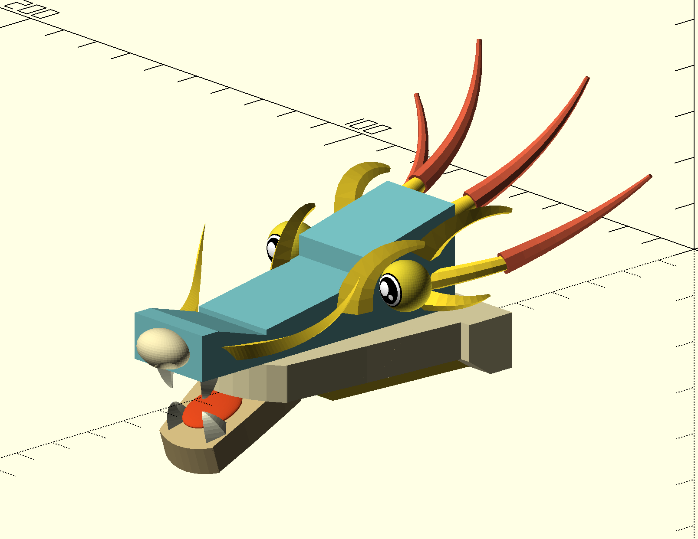
Figure 1. Dragon’s Head(Photo/Picture credit :Original)
To give the dragon's head a strong sense of dynamism and power, and to have enough width and depth to accommodate other details such as eyes and mouth, we start shaping the head's rough outline with multiple cubes and trapezoids. To obtain the dragon's cheeks, we horizontally stretch a cylinder, vertically compress it, and perform a Boolean difference operation with a cube. The result is the dragon's cheeks. At the same time, by using the linear_extrude function to extrude a parallelogram into a three-dimensional model and attaching it below the dragon's cheeks, we obtain the dragon's lower jaw. The main part of the dragon's head is colored cyan, bringing a sense of mystery and nobility to the dragon's head. The beige face can highlight the details of the dragon's head, such as the eyes, nostrils, and textures around the mouth, making the facial expressions more vivid. The yellow lower jaw can increase the visual focus of the dragon's head, making the dragon's expression more vivid, and also adds a bright color to the overall design. (Figure 2)
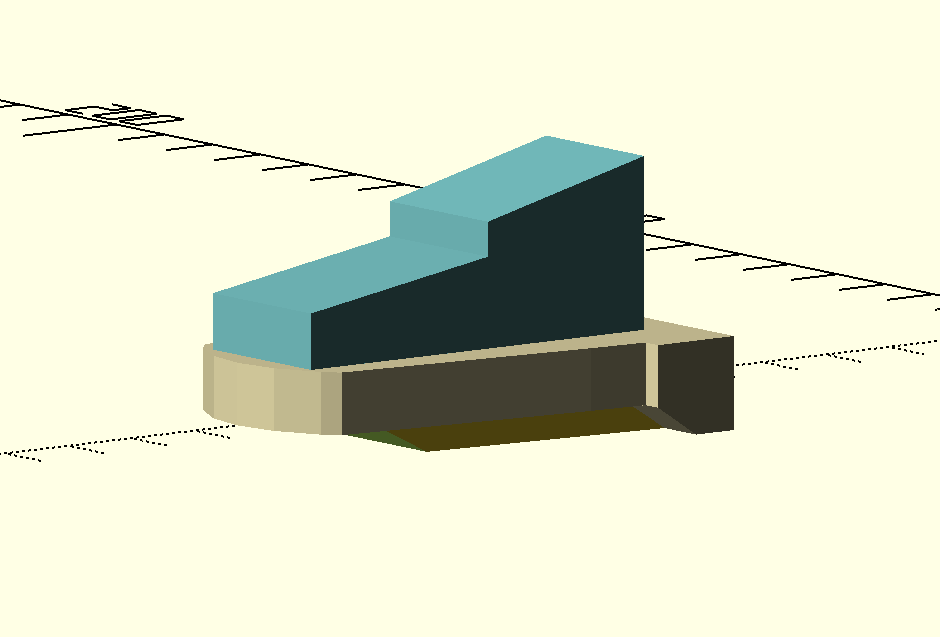
Figure 2. Main Head (Picture credit :Original)
The dragon's mouth, one of its most awe-inspiring features, is large and powerful, capable of opening at a wide angle. The model of the dragon's mouth is obtained by scaling and rotating the cheek model and attaching it to the dragon's lower jaw. To coordinate the mouth's color with other parts of the dragon, we designed it in a light brown color. The dragon's tongue is simply made by compressing a sphere into a flat biscuit shape. We set it to red, making the dragon look more vivid. (Figure 3(a))
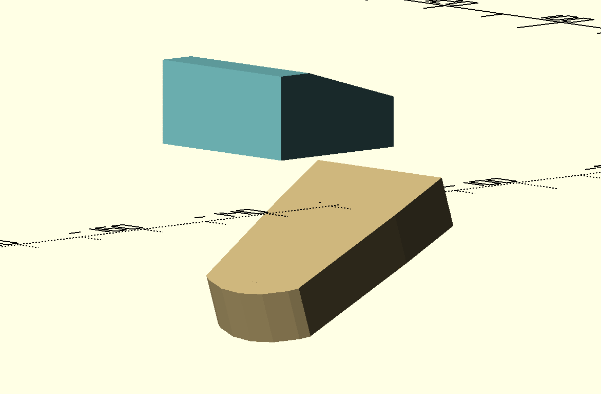
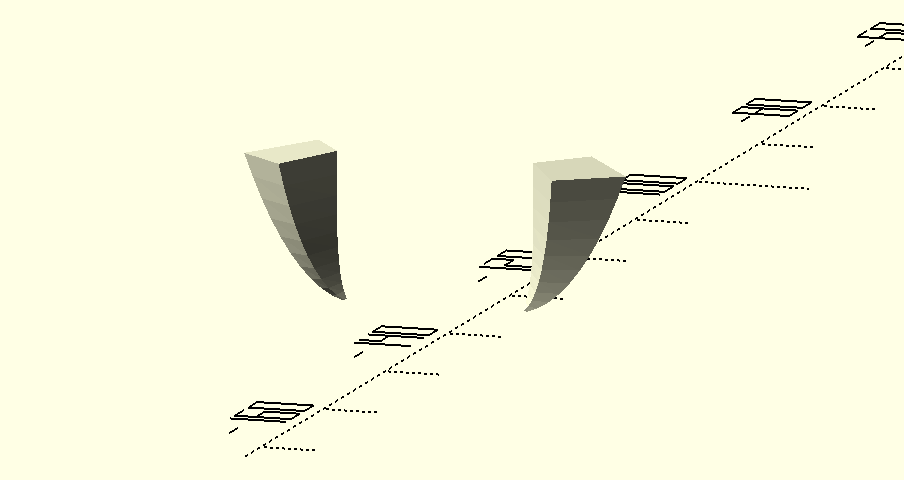
(a) | (b) |
Figure 3. (a)Mouth (b)Teeth (Picture credit :Original)
For modeling the dragon's teeth, we initially employed the path_extrude() function, which can generate a tetrahedral model based on a preset path and four given vertex coordinates. These four vertices define the basic shape of the tooth, while the path determines the extent to which the tooth bends along this shape, making each tooth not only structurally unique but also able to precisely mimic the curvature of real teeth.
To construct a complete set of dragon teeth, we used the copy(), mirror(), rotate(), and translate() functions. By copying a single tooth model, we were able to quickly generate the required number of teeth. The mirror operation ensures that the teeth are symmetrically arranged on both sides of the dragon's mouth, creating a balanced and natural appearance. Rotation and translation adjustments further refine the direction and position of each tooth to fit the specific structure and shape of the dragon's mouth, ensuring each tooth precisely slots into its designated spot.
In terms of coloring, we utilized the color() function to paint the dragon's teeth bone white, reflecting the natural color of teeth. (Figure 3(b))
Dragons possess a vision that can penetrate everything, capable of foreseeing the future or grasping hidden knowledge. Their eyes are usually visually striking, not only due to their size and shape but also because of their unique colors and luminescence.
We start by creating a spherical model representing the basic shape of the dragon's eye, laying the foundation for subsequent detail work. Using OpenSCAD's sphere() function, we can easily set the sphere's diameter and subdivision level to produce a smooth and three-dimensional eyeball model.
To simulate the dragon's pupil's unique shape and depth, we adopted a distinctive approach: first, we create a sphere model slightly smaller than the eyeball model at the same coordinates. Then, we add a cylindrical model designed to match the future pupil in position and size. By performing an intersection() Boolean operation, we retain only the part where this larger sphere intersects with the cylinder, forming a pupil model that protrudes from the surface of the eyeball.
Additionally, we employed Boolean operations for recreating the effect of sparkling light within the dragon's eyes. By adding a cylinder above the pupil and adjusting its position and size appropriately, we use the intersection() function to retain a small portion, simulating the highlight within the eye. Such highlights not only add realism to the eye but also enhance its mysterious and vivid visual effect.
In terms of color, by using different color() functions for the eyeball, pupil, and highlight areas, we can give the dragon's eyes unique colors and luminosity, thereby highlighting their visual appeal. This application of color not only reflects the physical characteristics of the dragon's eyes but also adds a layer of depth and mystery to the entire dragon model. (Figure 4(a)).
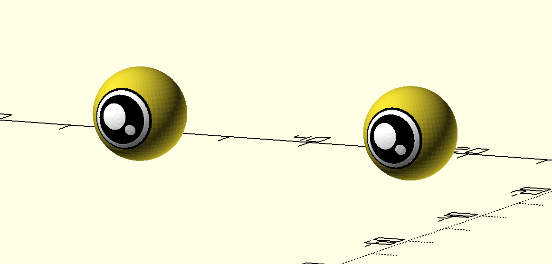
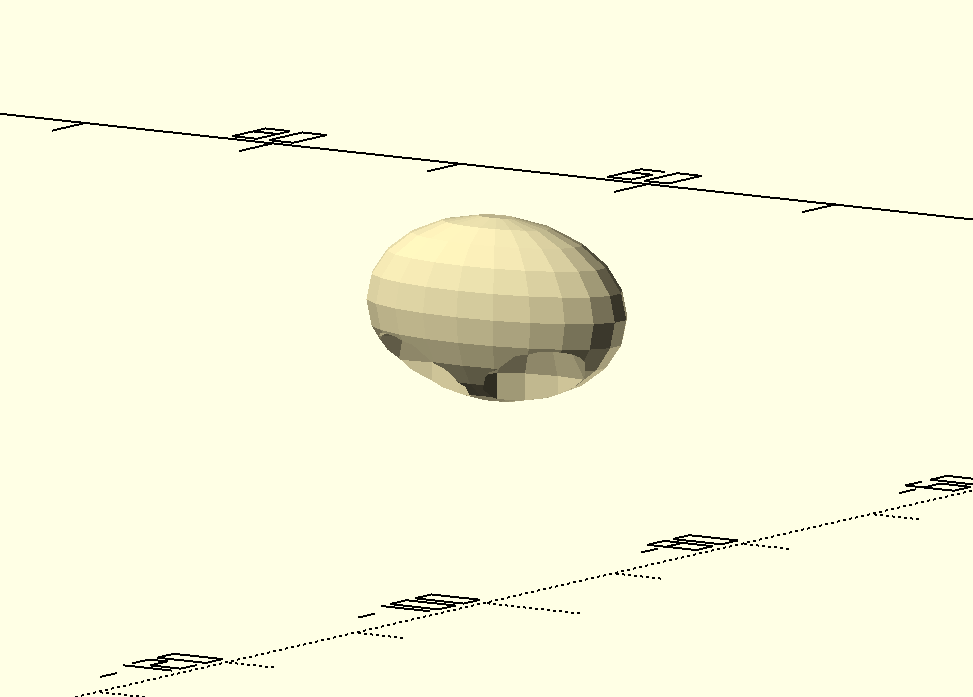
(a) | (b) |
Figure 4. (a) Eyes (b) Nose (Picture credit :Original)
Although the dragon's nose is a small part of its appearance, they play an indispensable role in adding richness to the dragon's expressions and biological characteristics. Its modeling is not complex. We compress a sphere into an ellipsoid using the scale function and perform a difference operation with two symmetrical spheres. This gives us a simple dragon nose (Figure 4 (b))
Dragon horns, symbols of strength and majesty, vary greatly in form, ranging from antler-like branches to curly ram horns and straight, sharp spikes. These forms not only reflect the dragon's race and attributes but also hint at their sources of power and personality traits. Bézier functions in CG are a type of parametric equation used to model smooth curves by adjusting the positions of control points. In this article, we generate the direction of dragon horns using the bezier_curve function as the path for the path_extrude function. At the same time, we set eight vertices for the path_extrude function to make the dragon horns smoother. The scale parameter of the path_extrude function is set to 0.5, making the dragon horns look sharper. The main color of the dragon horns is set to a vivid and deep red, giving the dragon a more intense and lively visual effect. At the same time, the red dragon horns not only enhance the appearance of the dragon but also provide a strong visual focus for the audience, adding attractiveness and memorability to the work [14] (Figure 5).
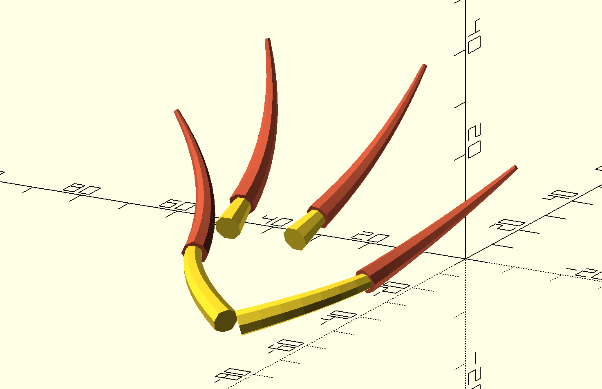
Figure 5. Dragon‘s Horns (Photo/Picture credit :Original)
The modeling method for the dragon's hair is similar to that of the teeth section. Multiple tetrahedron models are compressed horizontally and elongated vertically using the scale function, then fitted along the main part of the dragon's head. The beard part is made by using the linear_extrude function to elongate a square and rotate it 90 degrees (Figure 6).
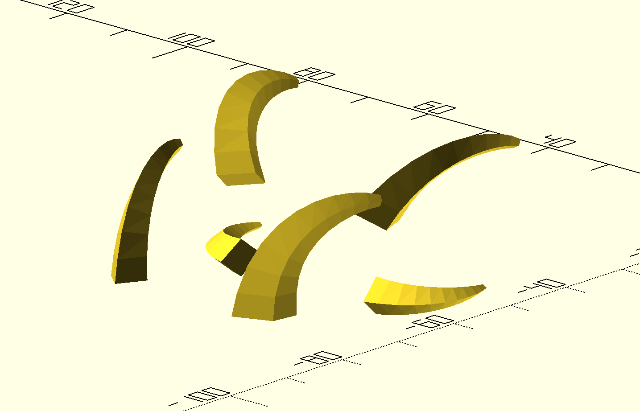
Figure 6. Dragon’s Facial Hair (Picture credit :Original)
3.2. Body
Modeling the body of a dragon is a complex and creative process that requires comprehensive consideration of the dragon's posture, scales, fins, color combinations, and overall proportions. Before beginning the modeling of the dragon's body, it is first necessary to determine its posture. Dragons have smooth and natural body lines, and traditional use of the linear_extrude function to construct the dragon's body cannot showcase the dragon's serpentine posture. Therefore, to reflect a lifelike posture, this article innovatively utilizes Bézier curves to construct the dragon's body posture, thereby better reflecting the posture of the dragon's body. Higher-order Bézier curves [15], with their high flexibility and controllability, are very suitable for this task. They can approximate any desired curve. We used 14 control points to design the dragon's posture into a curved shape. With the help of Bézier curves, the dragon's body becomes lifelike. (Figure 7)
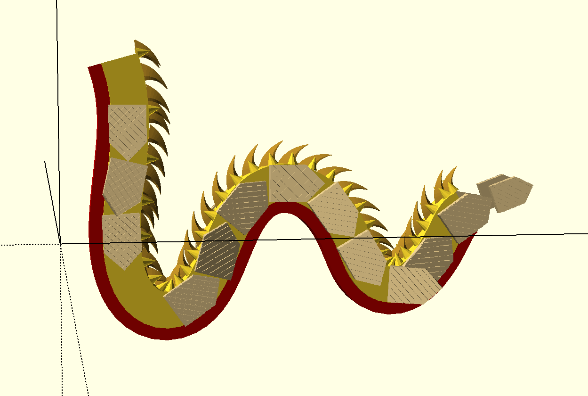
Figure 7. Dragon’s Body (Picture credit :Original)
The dragon's back is an important part of its powerful body, wide and strong. The modeling of the dragon's back is completed in two steps. First, the control points are passed into the bezier_curve function to obtain the serpentine path of the dragon's body, and then sf_thicken is used to give thickness to the obtained plane, turning it into a three-dimensional model. This creates the dragon's back. The dragon's back is painted a light yellow, making the entire dragon appear very agile (Figure 8 (a)).

(a) | (b) | (c) | (d) |
Figure 8. (a) Back (b) Belly (c)Dorsal Fins (d)Scale (Picture credit :Original)
The dragon's abdomen uses the same method, with the body's thickness set to 1.5 times that of the back, and the body's width set to 0.5 times that of the back. It is given a red color, enhancing the dragon's aesthetic appearance. (Figure 8(b))
The dragon's dorsal fins are obtained using the path_extrude function, inputting four vertex coordinates and a curved path for the dorsal fin. Next, the dorsal fins are placed one by one along the curved path of the dragon's body. (Figure 8(c))
Dragon scales are an important part of their magnificent appearance. I made them into pentagon shapes similar to arrows and used the linear_extrude function to stretch them into three-dimensional models. On each large dragon scale, I placed many small scales using a for loop function. Each small scale is obtained by scaling down the pentagonal dragon scales with the scale function and rotating them with the rotate function. This not only adds to the three-dimensionality of the dragon scales but also greatly reduces the amount of code.(Figure 8(d)) Then, by assembling the various parts together, the modeling of the dragon's body part is completed.
3.3. Claws
Dragon claws are typically depicted as long and sharp, resembling blades, but the dragon claws we've designed diverge significantly from the traditional depiction. We've infused the claws with a unique mechanical style. In the process of modeling dragon claws with OpenSCAD, we adopted innovative methods to realize this design. To create a smooth and curved appearance on the dragon toes, we chose to use Bezier curves to construct the surfaces of the toes. Specifically, we drew five Bezier curves that formed the perfect curvature and lines needed for the dragon toes, then linked these curves into a continuous surface. This approach provided the dragon toes with a smooth and natural shape, making the overall design of the dragon claw not only vivid but also highly original. (Figure 9(a))
For constructing the main body of the dragon claw, we started with basic cubic models and several irregular-shaped models. These irregular models were created using the polygon() function, where we input a series of coordinate points to define the outline of the dragon claw. We then used the linear_extrude() function to stretch these two-dimensional outlines into three-dimensional forms. This step was crucial in the modeling process of the dragon claw, as it provided the basic volume of the claw and allowed for more freedom and creative space in the design.
Finally, we simply needed to combine different models together, similar to assembling Lego bricks. Boolean operations played a crucial role in this process, especially when creating recessed parts on the dragon claw. We performed a difference operation with a specially deformed cubic model against the base model of the dragon claw, making it align more closely with the mechanical design concept. (Figure 9(b))
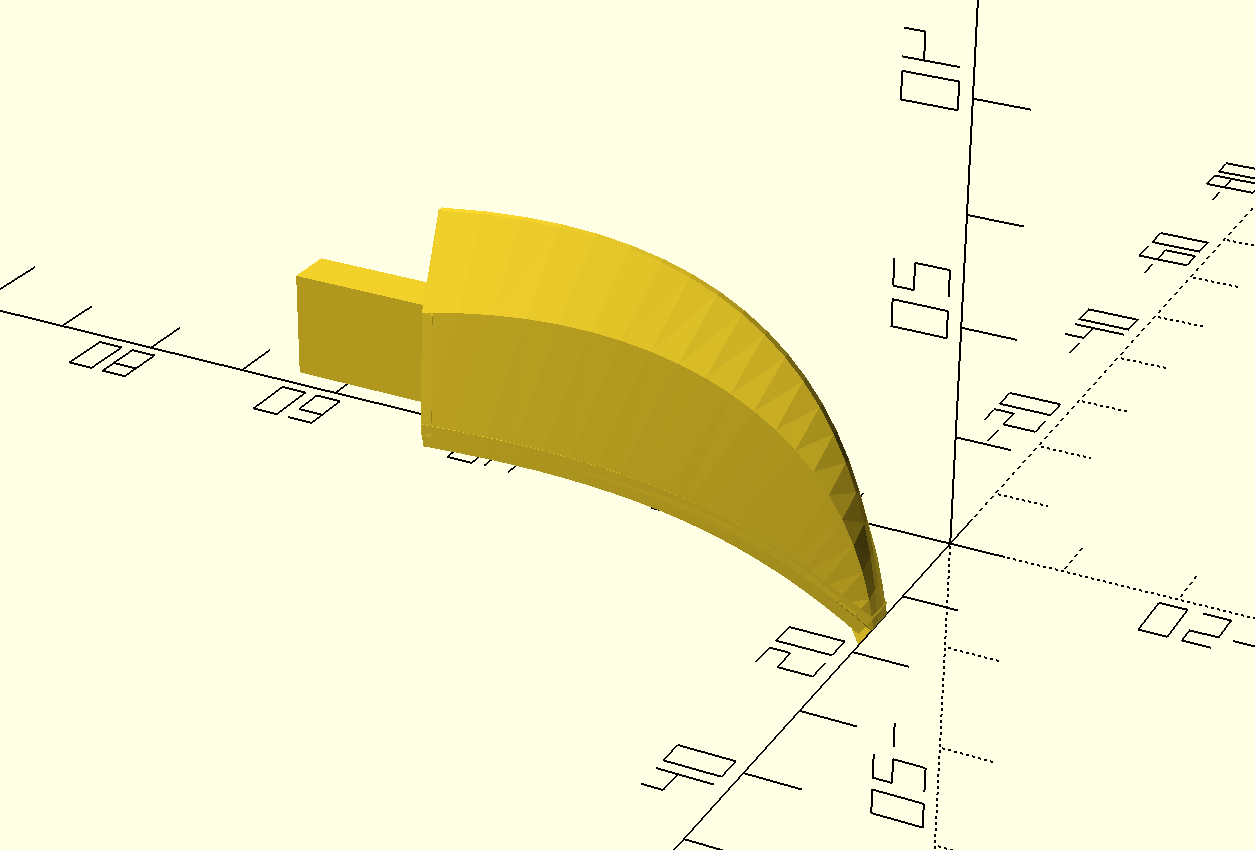
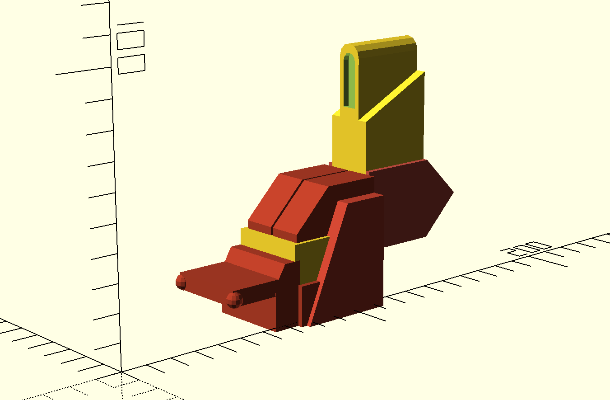
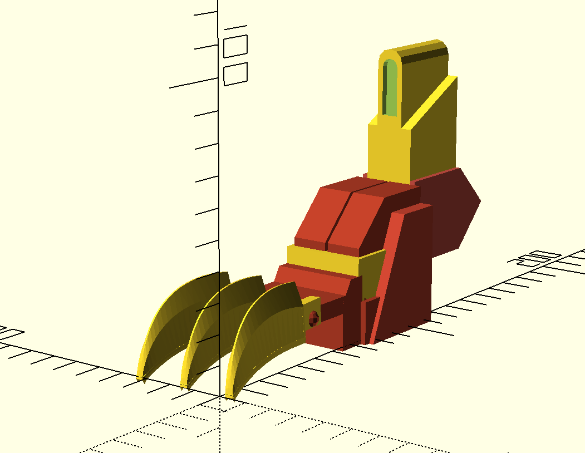
(a) | (b) | (c) |
Figure 9. (a) Nail (b) Main Claw (c) Dragon’s Claw (Picture credit :Original)
In terms of coloring, we chose a red and yellow alternating color scheme, implemented through OpenSCAD's color() function. The strong contrast between red and yellow not only enhanced the visual impact of the dragon claws but also added vibrancy to the mechanical style, making it a key element in showcasing the dragon's unique charm. (Figure 9(c)).
3.4. Tail
In the process of modeling the dragon's tail with OpenSCAD, we not only introduced elements of fire to symbolize the dragon's power and beauty but also ingeniously blended dynamic and artistic details to enrich the creation. By drawing more than 40 carefully selected vertices to form a branch of the dragon's tail, we captured the soul of dancing flames, making the dragon's tail appear to smoothly undulate in the air. Each vertex represents not just a moment of beauty in the flames but also weaves together a visual feast. Using the polygon function to connect these points into a surface, and then employing the linear_extrude function to stretch it into a three-dimensional model, we endowed the dragon's tail with a greater sense of volume and the dynamic essence of life (Figure 10(a)).
To construct the overall shape of the dragon's tail, we followed a series of steps, including stretching, inverting, and joining the tail branch models to create the preliminary outline of the tail. This process required precise geometric operations on each model, as well as duplication of these models, which were then formed into each segment of the tail through mirroring, scaling, and precise positional adjustments. This design approach ensured that each part was filled with power and vitality, displaying an unstoppable momentum like blazing flames (Figure 10(b)).
In terms of coloring, we used the color() function to impart rich colors to each layer of the dragon's tail, from the intense reds to the golden yellows, and up to the whites above the smoke. This combination of colors not only symbolizes the dragon's immense energy but also creates a dazzling visual canvas. The collision of these colors is not merely a display of beauty but a visual interpretation of the dragon's power and mystique, making the entire tail visually striking and attention-grabbing (Figure 10(c)).
By assembling each part together, we completed the modeling of the entire dragon.
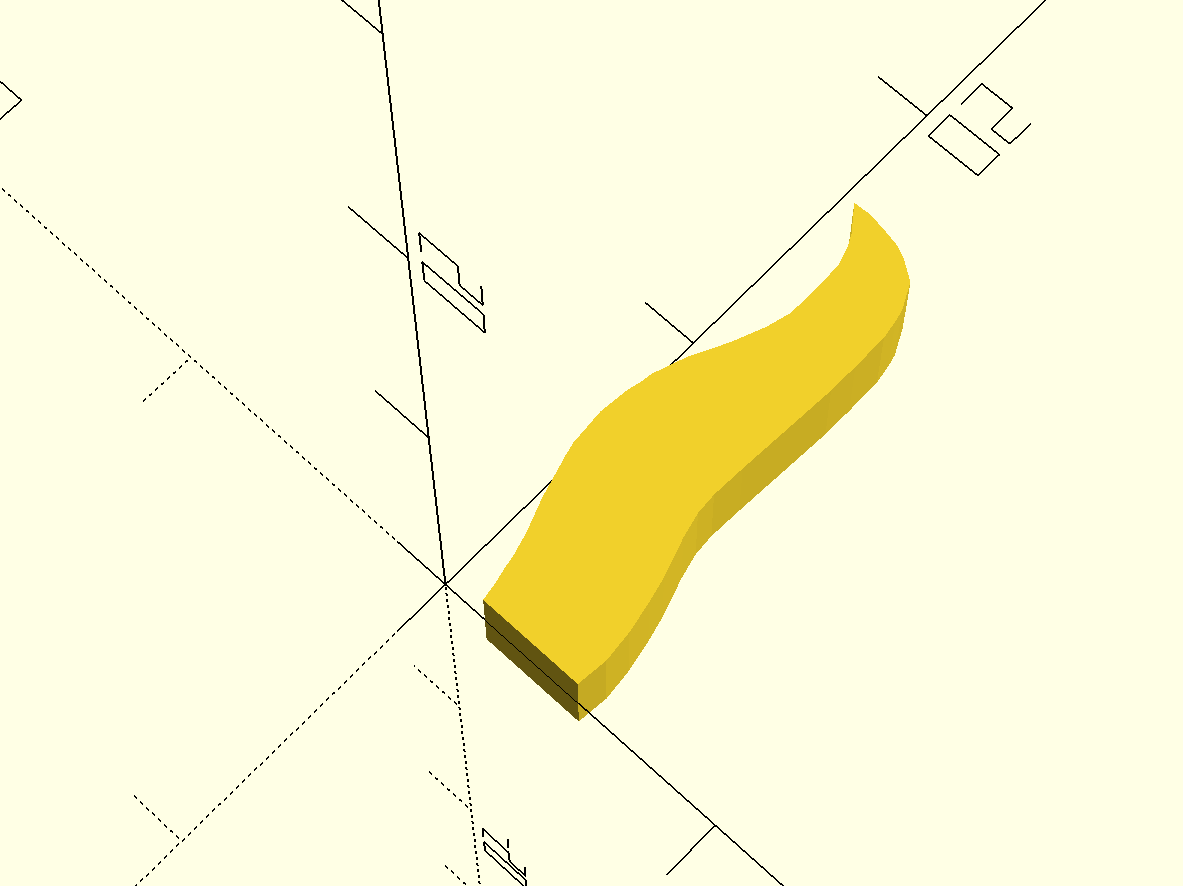
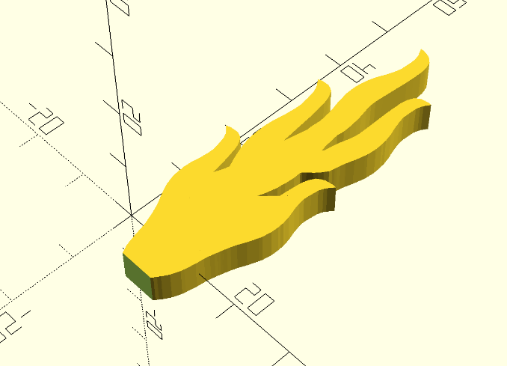
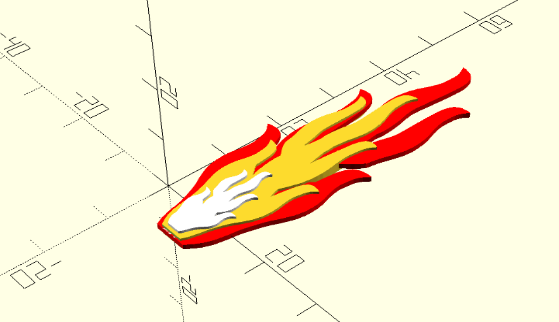
(a) | (b) | (c) |
Figure 10. (a)One Tail Branch (b)A Layer of The Dragon’s Tail (c)Dragon’s Tail (Picture credit :Original)
4. Result
4.1. Result Display
Through the in-depth use and exploration of OpenSCAD, we have successfully constructed a dragon model with significant Chinese cultural symbolism. It fully displays the traditional posture and shape features of the dragon, while also reflecting the infinite possibilities of modeling technology in CG. The Chinese dragon model presents a design that is both unique and rich in Chinese cultural characteristics. The dragon's pose is majestic and lively, its body winding and twisting, demonstrating powerful dynamics and graceful movements, and the red and yellow colors of its body make it look sacred and noble. The dragon's tail burns like a flame, creating a strong visual tension [16]. Every part of the dragon has been meticulously designed, from the broad back scales to the sharp claws, each part is full of character. The scales are tightly arranged along the body, giving a realistic texture and depth. The dragon's claws are sharp and powerful. The features of the dragon's head are precise and delicate, with eyes, nose, and horns all reflecting the accuracy of OpenSCAD in modeling complex details (Figure 11).
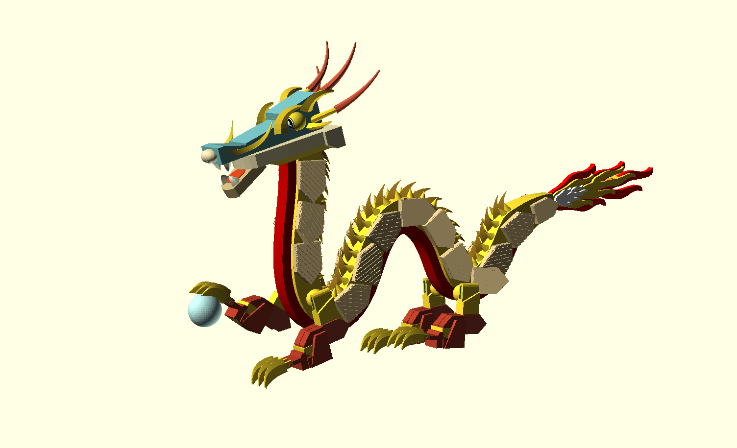
Figure 11. Chinese Dragon (Picture credit :Original)
Overall, the Chinese dragon model demonstrates the potential of combining modern modeling technology with traditional cultural elements. This dragon model not only visually displays the traditional beauty of the Chinese dragon but also shows the powerful capability of using OpenSCAD for complex biological modeling. Through this project, we have showcased the enormous potential of CG modeling technology in the integration of cultural heritage and modern technology.
4.2. Test evaluation
In our investigative study, to comprehensively evaluate the Chinese dragon modeled using OpenSCAD, we adopted a multidimensional assessment approach that encompasses key aspects such as visual effects, detail processing, posture representation, color coordination, and overall impression. We selected 20 university students from various disciplines as participants, aiming to gather evaluative feedback from multiple perspectives to ensure the breadth of our assessment results. These evaluators included students from arts and design, computer science, as well as literature and history, allowing for a diverse understanding of the Chinese dragon model's cultural and aesthetic values from multiple viewpoints.
To ensure the objectivity of our assessment, we provided participants with a detailed evaluation guide, which included specific explanations and scoring criteria for each assessment dimension. The specific evaluation guide is as follows in the table:
Table 1. Evaluation guide
Evaluation Dimensions | Definition | Focus | Scoring Criteria |
Visual Effects | Evaluates the overall visual appeal and impact of the model. | The model's initial visual impression, visual balance and contrast, and uniqueness. | 1 point indicates very poor, unattractive; 3 points indicate average, somewhat attractive but lacking uniqueness; 5 points indicate excellent, very appealing with a strong visual impact. |
Detail Processing | Evaluates the model's capability in reproducing details and complex elements. | The refinement of the model, the completeness of details, and their contribution to the overall design. | 1 point indicates rough details, improperly handled; 3 points indicate average details, properly handled in some areas; 5 points indicate exquisite details, perfectly reproduced complex elements. |
Posture Presentation | Evaluates whether the model accurately reflects the dynamic characteristics and agility of the Chinese dragon. | The sense of movement of the model, the natural fluidity of the posture, and whether it embodies the power and spirit of the Chinese dragon. | 1 point indicates a stiff posture, lacking a sense of dynamics; 3 points indicate an acceptable posture, partially reflecting dynamic characteristics; 5 points indicate a perfect posture, fully showcasing the agility and power of the Chinese dragon. |
Color Coordination | Evaluates the harmony of the model's colors and their cultural expressiveness. | The appropriateness of color choices, the harmony of color combinations, and whether the colors appropriately convey the cultural symbolism of the Chinese dragon. | 1 point indicates inappropriate color matching, inconsistent with cultural symbolism; 3 points indicate average color matching, partially meeting cultural requirements; 5 points indicate perfect color matching, fully consistent with cultural symbolism, enhancing the model's cultural depth. |
Overall Impression | A holistic evaluation of the model as a whole, including the innovation of the design and the depth of cultural expression. | The overall concept of the model, the integration of innovative elements, and the model's ability to express cultural symbolism. | 1 point indicates a mediocre overall model, lacking innovation and cultural depth; 3 points indicate an acceptable model design, with some innovation and cultural expression; 5 points indicate an outstanding model design, filled with creativity and deeply expressing cultural symbolism. |
We encouraged participants to provide objective and fair evaluations based on their intuition and professional knowledge, along with specific suggestions for improvement. (Table 2).
Table 2. The number of students who gave score for different aspects of the dragon
Score | Visual Effects | Detail Processing | Posture Representation | Color Coordination | Overall Impression |
1 | 0 | 0 | 0 | 0 | 0 |
2 | 0 | 0 | 0 | 0 | 0 |
3 | 0 | 2 | 0 | 1 | 0 |
4 | 3 | 3 | 4 | 2 | 5 |
5 | 17 | 15 | 16 | 17 | 15 |
Average | 4.85 | 4.65 | 4.8 | 4.8 | 4.75 |
According to the data in the table, the overall design of the dragon, with its fluid body posture and harmonious color coordination, was universally praised. However, we also recognized the limitations and potential areas for improvement encountered in the process of constructing complex 3D models using OpenSCAD.
Firstly, in terms of color representation, although OpenSCAD allows for basic color applications and we successfully used red and yellow color schemes to enhance the model's cultural characteristics and visual impact, the software's capabilities in material and lighting effects are relatively limited. This means that while the model's shape was accurately reproduced, there is still room for improvement in more complex lighting effects and material expressions.
Secondly, one specific challenge we encountered during the modeling process of the Chinese dragon was the excessive angularity of the dragon. This compromise in modeling somewhat reduced the richness of details, making the dragon's image appear too rigid and mechanical, and losing the fluidity that dragons represent in traditional culture. However, this also presents potential areas for improvement. For example, utilizing OpenSCAD's geometric operation features, functions such as minkowski() and hull() could be used to smooth edges and corners. This could reduce the angularity without altering the dragon's basic structure, making the model appear softer and more natural.
5. Conclusion
This article explores the potential of using OpenSCAD for constructing complex 3D models and demonstrates the possibilities of combining modern modeling techniques with traditional cultural elements. Additionally, it delves into a detailed discussion and analysis on how to create a dragon model enriched with Chinese traditional characteristics. Through the profound use and exploration of OpenSCAD, we not only revived the classic image of the Chinese dragon but also innovatively interpreted the model in terms of detail processing, color coordination, and overall design. We focused on the dragon model's posture display, shape features, and the meticulous crafting of details, especially on how to programmatically achieve the dragon's smooth curves and intricate scale textures. The dragon's body, with its red and yellow color scheme, enhances the model's cultural characteristics and visual impact. Through careful design and technical processing of the model's details, we have successfully presented a digital Chinese dragon with profound traditional aesthetics.
The Chinese dragon model showcases the powerful capability of using OpenSCAD for complex biological modeling. Through this project, the immense potential of CG modeling technology in merging cultural heritage with modern technology has been demonstrated. We hope to continue exploring ways to integrate traditional cultural elements with CG technology in the future, thereby promoting traditional culture. We look forward to contributing to the preservation and innovation of traditional culture alongside technological advancements.
References
[1]. Foley, J. D. (1996). Computer graphics: principles and practice ,Addison-Wesley Professional. Vol. 12110, pp.1-9.
[2]. Burdea, G. C., & Coiffet, P. (2003). Virtual reality technology. John Wiley & Sons 398, pp.1-12..
[3]. Shahrubudin, N., Lee, T. C., & Ramlan, R. J. P. M. (2019). An overview on 3D printing technology: Technological, materials, and applications. Procedia Manufacturing, 35, pp. 1286-1296.
[4]. Franke, H. W. (2012). Computer Graphics—Computer Art. Springer Science & Business Media 893 (3).
[5]. Wilson, J. K. (1990). Powerful form and potent symbol: The dragon in Asia. The Bulletin of the Cleveland Museum of Art, 77(8), pp.286-323.
[6]. Flavell, L. (2011). Beginning blender: open source 3d modeling, animation, and game design. Apress.
[7]. Palamar, T. (2013). Mastering Autodesk Maya 2014: Autodesk Official Press. John Wiley & Sons.
[8]. Shalannanda, W. (2020, November). Digital logic design laboratory using autodesk Tinkercad and Google classroom. In 2020 14th International Conference on Telecommunication Systems, Services, and Applications (TSSA (pp. 1-5). IEEE.
[9]. Lee, K. S., & Song, H. K. (2021). Automation of 3D average human body shape modeling using Rhino and Grasshopper Algorithm. Fashion and Textiles, 8, 1-20.
[10]. Machado, F., Malpica, N., & Borromeo, S. (2019). Parametric CAD modeling for open source scientific hardware: Comparing OpenSCAD and FreeCAD Python scripts. Plos one, 14(12), e0225795.
[11]. Luan, X., Xie, Y., Ying, L., & Wu, L. (2008). Research and development of 3D modeling. IJCSNS International Journal of Computer Science and Network Security, 8(1), pp. 49-53.
[12]. Makino, M., Suzuki, K., Takamatsu, K., Shiratori, A., Saito, A., Sakai, K., & Furukawa, H. (2018). 3D printing of police whistles for STEM education. Microsystem Technologies, 24, 745-748.
[13]. Zheng, L. (2024, February). Restore Traditional Chinese Lanterns Based on Openscad and Threejs. In 2023 International Conference on Data Science, Advanced Algorithm and Intelligent Computing (DAI 2023) (pp. 526-537). Atlantis Press.
[14]. Agoston, G. A. (2013). Color theory and its application in art and design, Springer, 19, pp.1-14
[15]. Farin, G. (1983). Algorithms for rational Bézier curves. Computer-aided design, 15(2), pp.73-77.
[16]. Heinstein, R. (2014). Visual Tension in Graphic Design.Western Kentucky University.
Cite this article
Li,G. (2024). Chinese dragon modeling based on Openscad. Applied and Computational Engineering,67,1-12.
Data availability
The datasets used and/or analyzed during the current study will be available from the authors upon reasonable request.
Disclaimer/Publisher's Note
The statements, opinions and data contained in all publications are solely those of the individual author(s) and contributor(s) and not of EWA Publishing and/or the editor(s). EWA Publishing and/or the editor(s) disclaim responsibility for any injury to people or property resulting from any ideas, methods, instructions or products referred to in the content.
About volume
Volume title: Proceedings of the 2nd International Conference on Software Engineering and Machine Learning
© 2024 by the author(s). Licensee EWA Publishing, Oxford, UK. This article is an open access article distributed under the terms and
conditions of the Creative Commons Attribution (CC BY) license. Authors who
publish this series agree to the following terms:
1. Authors retain copyright and grant the series right of first publication with the work simultaneously licensed under a Creative Commons
Attribution License that allows others to share the work with an acknowledgment of the work's authorship and initial publication in this
series.
2. Authors are able to enter into separate, additional contractual arrangements for the non-exclusive distribution of the series's published
version of the work (e.g., post it to an institutional repository or publish it in a book), with an acknowledgment of its initial
publication in this series.
3. Authors are permitted and encouraged to post their work online (e.g., in institutional repositories or on their website) prior to and
during the submission process, as it can lead to productive exchanges, as well as earlier and greater citation of published work (See
Open access policy for details).
References
[1]. Foley, J. D. (1996). Computer graphics: principles and practice ,Addison-Wesley Professional. Vol. 12110, pp.1-9.
[2]. Burdea, G. C., & Coiffet, P. (2003). Virtual reality technology. John Wiley & Sons 398, pp.1-12..
[3]. Shahrubudin, N., Lee, T. C., & Ramlan, R. J. P. M. (2019). An overview on 3D printing technology: Technological, materials, and applications. Procedia Manufacturing, 35, pp. 1286-1296.
[4]. Franke, H. W. (2012). Computer Graphics—Computer Art. Springer Science & Business Media 893 (3).
[5]. Wilson, J. K. (1990). Powerful form and potent symbol: The dragon in Asia. The Bulletin of the Cleveland Museum of Art, 77(8), pp.286-323.
[6]. Flavell, L. (2011). Beginning blender: open source 3d modeling, animation, and game design. Apress.
[7]. Palamar, T. (2013). Mastering Autodesk Maya 2014: Autodesk Official Press. John Wiley & Sons.
[8]. Shalannanda, W. (2020, November). Digital logic design laboratory using autodesk Tinkercad and Google classroom. In 2020 14th International Conference on Telecommunication Systems, Services, and Applications (TSSA (pp. 1-5). IEEE.
[9]. Lee, K. S., & Song, H. K. (2021). Automation of 3D average human body shape modeling using Rhino and Grasshopper Algorithm. Fashion and Textiles, 8, 1-20.
[10]. Machado, F., Malpica, N., & Borromeo, S. (2019). Parametric CAD modeling for open source scientific hardware: Comparing OpenSCAD and FreeCAD Python scripts. Plos one, 14(12), e0225795.
[11]. Luan, X., Xie, Y., Ying, L., & Wu, L. (2008). Research and development of 3D modeling. IJCSNS International Journal of Computer Science and Network Security, 8(1), pp. 49-53.
[12]. Makino, M., Suzuki, K., Takamatsu, K., Shiratori, A., Saito, A., Sakai, K., & Furukawa, H. (2018). 3D printing of police whistles for STEM education. Microsystem Technologies, 24, 745-748.
[13]. Zheng, L. (2024, February). Restore Traditional Chinese Lanterns Based on Openscad and Threejs. In 2023 International Conference on Data Science, Advanced Algorithm and Intelligent Computing (DAI 2023) (pp. 526-537). Atlantis Press.
[14]. Agoston, G. A. (2013). Color theory and its application in art and design, Springer, 19, pp.1-14
[15]. Farin, G. (1983). Algorithms for rational Bézier curves. Computer-aided design, 15(2), pp.73-77.
[16]. Heinstein, R. (2014). Visual Tension in Graphic Design.Western Kentucky University.





